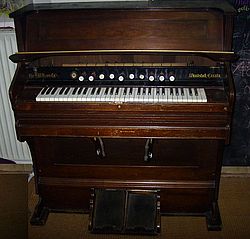Wednesday, 22 June 2011
GUDOK
A gudok usually had three strings, two of them tuned in unison and played as a drone, the third tuned a fifth higher. All three strings were in the same plane at the bridge, so that a bow could make them all sound simultaneously. Sometimes the gudok also had several sympathetic strings (up to eight) under the sounding board. These made the gudok's sound warm and rich
HARMONIUM
A harmonium is a free-standing keyboard instrument similar to a reed organ. Sound is produced by air being blown through sets of free reeds, resulting in a sound similar to that of an accordion. The air is usually supplied by bellows operated by foot, hand, or knees.
In North America, the most common pedal-pumped free-reed keyboard instrument is known as the American Reed Organ, (or parlor organ, pump organ, cabinet organ, cottage organ, etc.) and along with the earlier melodeon, is operated by a suction bellows where air is sucked through the reeds to produce the sound. A reed organ with a pressure bellows, that pushes the air through the reeds, is referred to as a harmonium.
In North America, the most common pedal-pumped free-reed keyboard instrument is known as the American Reed Organ, (or parlor organ, pump organ, cabinet organ, cottage organ, etc.) and along with the earlier melodeon, is operated by a suction bellows where air is sucked through the reeds to produce the sound. A reed organ with a pressure bellows, that pushes the air through the reeds, is referred to as a harmonium.
HARMONICA
A harmonica is small musical instrument that is played with the mouth by blowing into holes in its side. Harmonicas are cheap and easy to play. Harmonicas make their musical sounds from the vibrations of reeds in the harmonica's metal case. Harmonicas are used in blues music, folk music, rock and roll music, and pop music.
DARBUKA
The goblet drum (also chalice drum, darbuka, doumbek or tablah) is a hand drum with a goblet shape used mostly in the Middle East, North Africa, and Eastern Europe.
Though it is not known exactly when these drums were first made, they are known to be of ancient origin. Some say they have been around for thousands of years, used in Mesopotamian and Ancient Egyptian cultures. There has also has been some debate that they actually originated in Europe and were brought to the Middle East by nomadic Celtic tribes.
Though it is not known exactly when these drums were first made, they are known to be of ancient origin. Some say they have been around for thousands of years, used in Mesopotamian and Ancient Egyptian cultures. There has also has been some debate that they actually originated in Europe and were brought to the Middle East by nomadic Celtic tribes.
CONGGA
The conga, or more properly the tumbadora, is a tall, narrow, single-headed Cuban drum with African antecedents. It is thought to be derived from the Makuta drums or similar drums associated with Afro-Cubans of Central African descent. A person who plays conga is called a conguero. Although ultimately derived from African drums made from hollowed logs, the Cuban conga is staved, like a barrel. These drums were probably made from salvaged barrels originally. They are used both in Afro-Caribbean religious music and as the principal instrument in rumba.
Subscribe to:
Comments (Atom)




